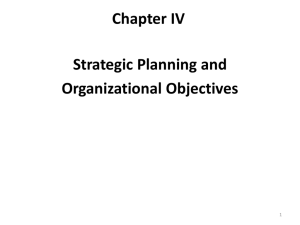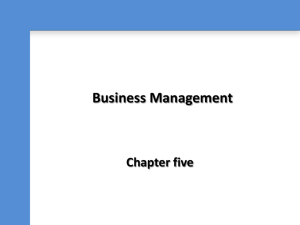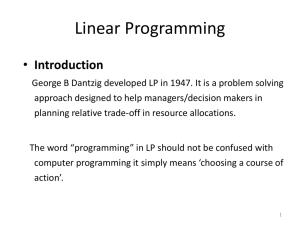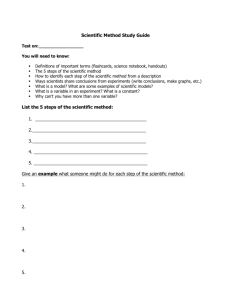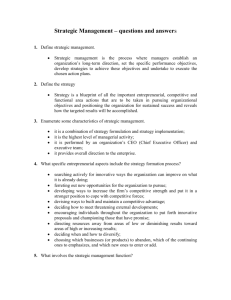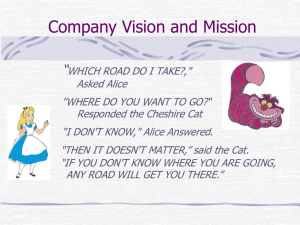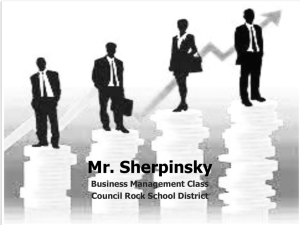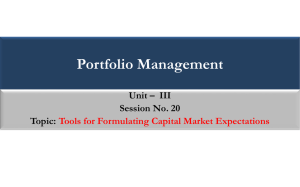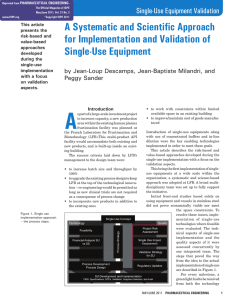Chapter 07 Organizational Planning and Goal Setting
advertisement
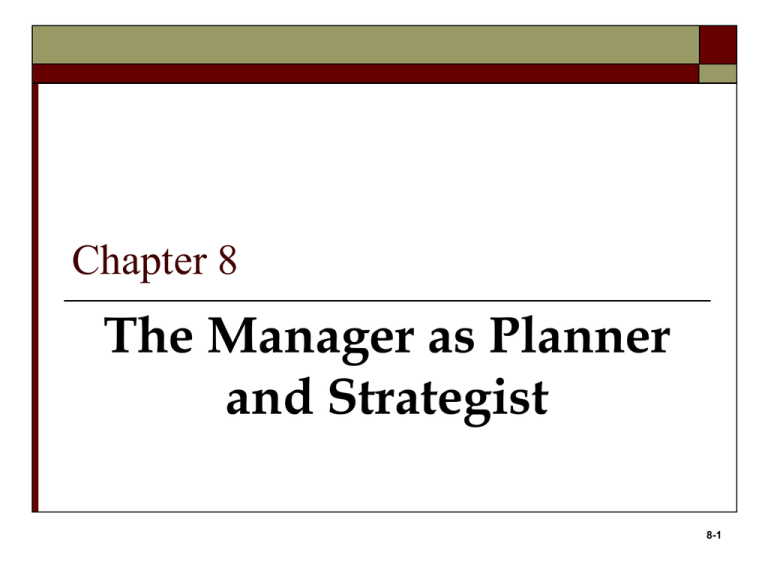
Chapter 8 The Manager as Planner and Strategist 8-1 Learning Objectives 1. 2. 3. 4. 5. 6. 7. Describe the three steps of the planning process and the relationship between planning and strategy. Differentiate between corporate-, business-, and functionallevel planning Explain the concept of organizational mission and how it influences goal setting and planning. Explain the difference between single-use plans and standing plans. Define the characteristics of effective goals. Describe the strategic planning process and SWOT analysis. Describe corporate-level strategies. 8-2 Learning Objectives (contd.) 8. 9. Describe business-level strategies, including Michael E. Porter’s plan to gain competitive advantage. Describe the role of functional-level strategy. 8-3 Why Plan? Stephen Robbins and David DeCenzo use an example from Alice in Wonderland to put the function of planning in perspective. When Alice came to a fork in the road, she asked the Cheshire cat for directions. The cat asked, “Where do you want to go?” Alice replied that it didn’t matter. The cat said “Then either road will take you there.” If an organization doesn’t know where it wants to go – getting “there” may prove difficult. 8-4 What are Some Problems with Formal Planning? Plans can become rigid Formal plans often do not hold up in a changing environment Planning can sometimes focus more attention on today’s competition and less on tomorrow’s environment Planning isn’t a replacement for creativity 8-5 Planning Process Identifies and selects appropriate goals and courses of action for the organization Goal A desired future state that the organization attempts to realize. Strategy The decisions and actions managers take to attain goals. 8-6 Three Steps in Planning 8-7 Levels and Types of Planning 8-8 Levels of Planning Corporate Level - Large organizations which compete in many different industries and markets Business Level – An organization which competes within a specific industry Functional Level – A unit or department within a business in which people have similar skills and resources such as marketing, manufacturing, 8-9 Single-Use and Standing Plans Single-Use Plans Plans developed for goals which are unlikely to be repeated – to meet a unique situation Example: patching computer systems for change in daylight savings dates, mergers of companies Standing Plans On-going policies, rules and procedures for activities performed repeatedly – makes sense to have standing procedures Example: UPS package delivery procedures, registration for classes. 8-10 Scenario Planning Generate multiple possible “futures” and prepare for possible outcomes (contingency planning). Identify important factors which may occur in environment – housing construction prepares for rise in interest rates Develop plans for organization’s response – focus on worst case scenario alternative financing in housing Scenario Building - Pentagon Develop plans for crisis situations or emergencies 8-11 Purpose of Planning Legitimacy/mission statement Source of motivation and commitment Sense of direction and purpose Coordination of organizational functions Specifies responsibility Standard of performance 8-12 Determining Mission and Goals Mission Statement General statement of organization’s reason for being Includes values and aspirations Identifies products and customers eBay: eBay's mission is to provide a global trading platform where practically anyone can trade practically anything. Google: Google Corporate Information: Company Overview 8-13 Determining Mission and Goals College of Business Mission Statement The College of Business seeks to bring the unchanging values of Auburn University – Practical Education and Research, Honesty, and Hard Work – to a changing world. Through the creation, application, and dissemination of business knowledge, we fulfill the needs of our many constituencies. Through professional programs that integrate individual responsibility, initiative, and teamwork with essential knowledge, we help students with diverse backgrounds become Auburn Men and Women, able to succeed professionally without compromising those values that make success worthwhile. Our community of students, faculty, staff and alumni operates on the shared principles of the Auburn Creed. We believe it is a lifelong guide for an ethical personal and professional life. 8-14 Characteristics of Effective Goals SMART Goals Specific Measurable Attainable - challenging but realistic. Results - oriented Target dates 8-15 Formulating Strategy Develop strategies to accomplish mission and goals To position the organization to its best competitive advantage in the environment Analyze factors which affect the organization’s ability to meet its goals Strategies which Focus on Core Competencies Develop Synergy Create value for Customers 8-16 Formulating Strategy SWOT analysis Strengths Weaknesses Opportunities Threats Internal analysis External Environment 8-17 Formulating Strategy 8-18 Formulating Strategy Internal Strengths and Weaknesses Look at all aspects of the organization: Management and organizational structure Marketing Human Resources Finance Production Research and Development 8-19 Formulating Strategy External Threats and Opportunities General Environment (Chapter 6) Technological Socio-cultural Economic Political and Legal Demographic Task Environment Customers Competitors Suppliers Distributors 8-20 Formulating Strategy Michael Porter’s Five Forces Model Competitive Forces Level of Rivalry Increased competition results in lower profits. Potential for Entry Easy entry leads to lower prices and profits. Power of Suppliers If there are only a few suppliers of important items, supply costs rise. Power of Customers If there are only a few large buyers, they can bargain down prices. Substitutes More available substitutes tend to drive down prices and profits. 8-21
